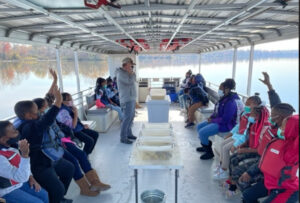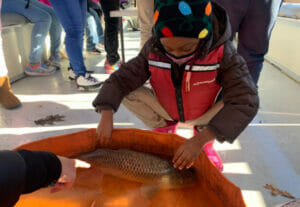“We had the best time and our kids haven’t stopped talking about it. This was the best field trip experience I have been on as a teacher.” This is just one of the many positive emails I have received following an outdoor field experience with the James River Association (JRA). In the summer of 2021, Henrico County Public Schools was awarded a $20,000 grant from the Virginia Department of Conservation and Recreation. Through this grant, Henrico had the unique opportunity to provide fourth grade students in ten of our Title I schools with an engaging field experience led by the educators at the James River Association. This field trip supports the study of watersheds and Virginia’s Natural Resources (SOL 4.8). In addition, this trip directly connects to their Meaningful Watershed Educational Experience (MWEE) plans and our goal of ensuring that our students are environmentally literate stewards who understand the importance of protecting our watershed. While watersheds are a primary focus, students are also learning about the wetland ecosystem and the numerous species of plants and animals that call the James River their home.
Through this partnership with JRA, students and teachers were able to participate in a variety of activities to expand their understanding of our James River watershed. Prior to their field trip, students participated in an interactive virtual lesson to meet the JRA educators and learn important background information that would support their learning during the field experience. During the lesson, students explored a map of Virginia and its bordering states and identified the sources of water in Virginia. They reviewed the four major rivers, James, York, Rappahannock, and Potomac, and identified how all of these rivers flow into the Chesapeake Bay and eventually into the ocean. Through a 360 interactive, students were able to dive into the James River and explore the plants and animals that live underwater. The students were engaged throughout the Nearpod lesson and were more prepared to extend their learning on the upcoming field experience.
On the day of the field trip, students traveled to Deep Bottom Park in Varina, VA where they participated in two stations to explore both the land and the water. On land, students were able to take a short hike to a location where they could see the James River on one side and Four Mile Creek on the other. On this silent hike, students listened carefully and made observations about the land and water around them. They heard the crunching of the fall leaves on the ground and owls communicating in the distance. They observed bird houses that have been installed to increase the number of prothonotary warblers on the James River. Students saw a great blue heron standing very still on the bank of the river hunting for fish to eat. They saw plants growing out of the water and tall marsh grasses blowing in the wind. Students shared their observations and asked questions about the ecosystem they were exploring. They learned how wetlands filter water, absorb excess runoff to prevent floods, and provide habitats. Students also selected leaves from the ground and made observations to identify from which tree the leaf fell. The JRA educators discussed native and invasive species of plants and explained the important role that plants play in our local watershed.
Students also had the opportunity to explore the James River from The Spirit of the James, a 45 foot pontoon boat. For many of our students, this was their first experience riding on a boat and exploring the water. As the captain navigated the boat down the James, the students made observations and were very inquisitive. When they spotted a bald eagle, the educators explained the effect that a pesticide called DDT had on the bald eagle population and how a species that was near extinction is now thriving on the James River. They learned that the brown color of the water is a result of sediment pollution caused by erosion which prevents sunlight from reaching the underwater plants. Without adequate sunlight, underwater plants can not do photosynthesis, which impacts the producers in the river food chain.

The students were so excited when the captain announced that we would be catching some fish today! The educators led a discussion about animals that we may find in the James River and students predicted what they may catch in the net. After trawling with the net for a few minutes, students worked together to pull in the rope. All eyes were focused on the net as they tried to figure out what they had caught. The educators carefully placed the fish into clear bins filled with water so that all students could make observations and use the laminated picture guides/keys to try to identify the fish they had caught. Students and teachers loved being able to touch and hold the fish! What a catch! Catfish, crab, hogchoker, carp, bowfin, and more! The JRA educators discussed each fish that we had caught and reviewed the behavioral and physical adaptations that help each fish to survive in their habitat. Students learned that the variety of species we collected in the trawl net is an important indicator of the health of the James River.This field experience provided hands-on, relevant, and engaging information that encouraged students to be good stewards of the environment. As part of their Meaningful Watershed Education Experience, students complete an action project to help our James River Watershed and bring awareness to the need to conserve this important natural resource. Using the most current State of the James Report from James River Association helps our students to identify an area of focus. Some action projects include painting storm drains, making posters, filming public service announcements, and cleaning up litter on the school grounds. This field experience on the James River enhances the students’ understanding and interest in protecting this amazing resource that is in their own backyard.
